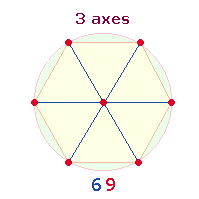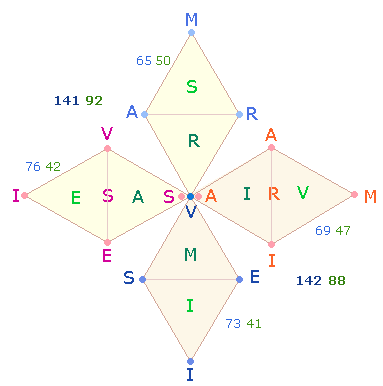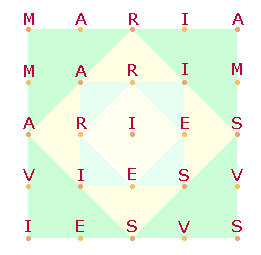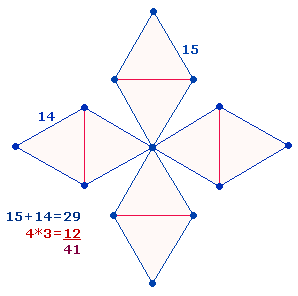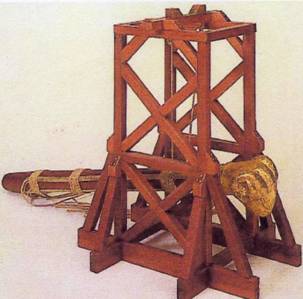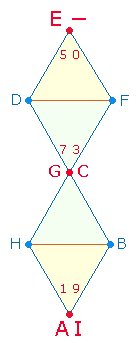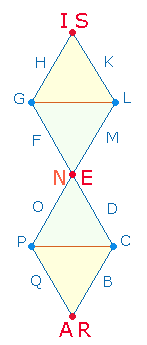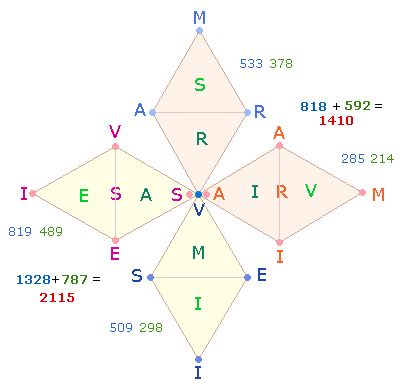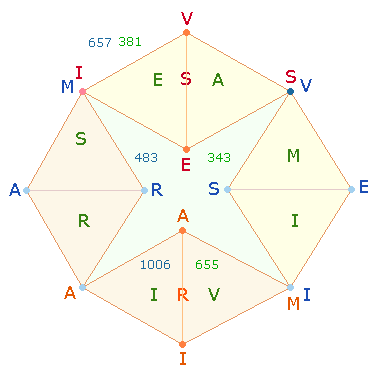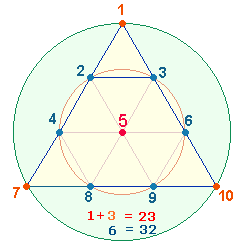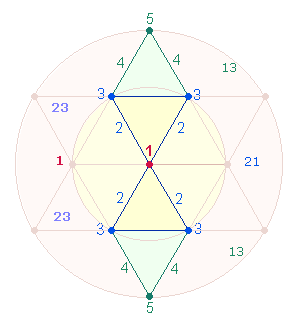Alphabets;
gematric calculator
Shakespeare's
Epitaph
L.
Shakespeare's Love for Jesus and Mary
His most ambitious gematric construction
K. Shakespeare understands himself as Mary's son
|
GOOD FREND FOR IESVS SAKE FORBEARE |
|
TO DIGG THE DVST ENCLOASED HEARE. |
|
BLESTE BE YE MAN YT SPARES
THES STONES |
|
AND CVRST BE HE
YT MOVES MY
BONES. |
I. Introduction
III.
Implications of the Construction
a) Introduction
b) The values of
the double-rhombi
c) The 25 letters and
the SATOR Square
d) ARIES – RAM
IV. Shakespeare's analogous construction
V. Meaning of 75*47
b) Relation to the Double-Rhombus
I. Introduction
1. Roman gematria drew its
enormous effectiveness from the most objective system of order, the system of
numbers organised in the decimal system. Shakespeare could apply the principles
of gematria by studying the classical works of Roman poets, especially of Ovid.
Shakespeare
also realized that the values of significant Christian terms and names were in
full conformity with the principles of the decimal system. He must have come to
the conclusion that the human mind could discover the numerological relations
and meanings of words, but that the formation of these words
and their relations were created by a supreme divine plan.
2. The names of MARIA and IESUS seem to give proof of
the decimal system as the central gematric model of reference, both consisting
of 5 letters. Their numeric values (NV) are 40 and 70, forming the ratio 10*(4:7) with 11 as average value per
letter.
If the name CHRISTUS (112) is added, the sum 222 = 6*37 establishes a significant
relation to WILLIAM (74 = 2*37).
3. Shakespeare certainly
knew the
The
4. The last letters A and S occur a second time in
MARIA and IESUS. Furthermore the lette I appears in both names.
So Shakespeare could assign the frequency of letters in his epitaph to three options of the two names which form the basis for the following
study.
II. The Model Construction
1.
Before Shakespeare set out for his geometric construction,
he counted the numerical values (NV) and factoral values (FV) of the three options (O):
|
|
O1 |
O2 |
O3 |
|
||
|
|
MARIA |
IESUS |
MARI |
IESU |
MARIESU |
|
|
NV |
40 |
70 |
39 |
52 |
82 |
283 |
|
FV |
32 |
36 |
31 |
28 |
53 |
180 |
|
|
72 |
106 |
70 |
80 |
135 |
463 |
The 7 letters of the third
option can be divided up into 3-1-3:
|
|
MAR |
I |
ESU |
|
NV |
30 |
9 |
43 |
|
FV |
25 |
6 |
22 |
|
|
55 |
15 |
65 |
If I
is added to MAR, the ratio of the NS+FS is 5*(14:13). In the hexagon one
axis consists of 2 lines and 3 points, which amounts to 6+9 for three axes. As 9 has
the FV 6, it is the relevant number for its composite equivalent 69, the NV for SATOR – Creator:
|
|
The NS 283, understood as 28+3, points to a cross
made of two double rhombi, with 4*7 frame elements plus 3 central points. This
imagined figure can be put together to an octahedron.
2.
Shakespeare now had to try to put up the 25 letters of the three
options in this figure: 7 letters, 5+5 letters, and 4+4 letters:
The 7 letters can be placed
on the 7 points of the vertical double rhombus. It makes good
sense to start the names from their opposite positions and proceed in the
mirror image way to the centre. As start is chosen the lowest point and the
name of IESUS.
The twice
5 letters should find
their place on the horizontal double rhombus, again in concentric manner from the
margin to the centre. Each rhombus provides 4 points and 1 cross line.
The twice 4 letters should connect
the two double rhombi. This is best possible if the outer and inner triangles
are occupied clockwise, starting with IESUS on the outer and going on with MARIA on the inner ring:
|
|
The three
central letters read SVA – his own, his property. Related to Jesus
Christ, it reminds of St. John's prologue (1,11):
In propria venit et sui eum non
receperunt.
He came to that which was is own and his own did not receive
him.
By a
change of letters the word VAS – vessel is formed. This refers to the
octahedron that can be made of two crossed double-rhombi. VAS stands for God's
creation, the KOSMOS, which is an image of himself. God is on the one hand
absolute, on the other hand he is present in his creation. MARIA and IESUS are
God's most perfect creations. Under Mary's assistance Jesus performed the work
of redemption, renewing the face of creation.
3.
Two rectangular rhombi can be shifted towards the to other
two so that an octagon is the result. There can be two different combinations
of rhombi and two different shifts. The decision for the right shift depends on
which values of two rhombi harmonize best, either in themselves or in relation
to the other two. In the above figure the values of the left and top rhombi
harmonize best: NS 142:141, FS 92:88:
|
|
III. Implications of the Construction
a) Introduction
1.
The added NV of MARIA and IESUS are 40+70 = 110. The added single
numbers of the ratio 10*(4:7) and the factors 11*10 point to the 21 elements of the double-rhombus. But they also refer to
the 3*7 = 21 elements of the tetraktys frame. One side of the
tetraktys triangle is to be considered as a complete unit, to which its parts
can be related. As one side consists of 4 points and 3 lines, two ratios 4:7 and 3:7 can be formed. The
same applies to the 3*5 = 15 elements of the
hexagon axes with the ratios 3:5 and 2:5. The three axes and the three tetraktys sides form
an coherent structure:
|
|
2.
The inner coherence becomes evident if the ratios
mentioned are treated as 2-digit numbers and the FV of the upward and
downward numbers are established:
|
|
|
|
|
|
sm |
sm |
|
up |
35 |
25 |
37 |
47 |
144 |
|
|
FV |
12 |
10 |
37 |
47 |
|
106 |
|
down |
53 |
52 |
73 |
74 |
252 |
|
|
FV |
53 |
17 |
73 |
39 |
|
182 |
|
|
|
|
|
|
396 |
288 |
|
144:252=36*(4:7);288:396=36*(8:11) |
||||||
The NS of the two groups of
numbers are to each other as 4:7 like the NS of MARIA and IESUS , and the FS 288 shares with the NS 396 the common divisor 36. 106 is the NS+FS of IESUS, 182 the NS of IESUS
CHRISTUS.
3.
Each of the 3 tetraktys sides consists of 4 points and 3 lines, together 12+9.= 21. The partial number 12 so is to the complete number 21 as 12:21 = 3*(4:7). The partial number 12 must be repeated in
the second part of the ratio: 12:(12+9).
The numbers 12 and 9 are the NV of the initials of MARIA and IESUS. Mother and Son form a complete
unit of 21. If M = 12 is to be related to the total sum of 21, the ratio would have
to be in terms of letters M:(M+I). Mary's double presence might be
interpreted as her status of both Virgin and Mother.
b) The values of the double-rhombi
1.
If the Model Construction shown above is to have objective
quality, some numeric evidence should be found. This is the case, if the FV of the NS and FS of the vertical (V) and the horizontal (H) double-rhombus are
established:
|
V |
NS/FS |
73 |
41 |
65 |
50 |
|
|
|
FV |
73 |
41 |
18 |
12 |
144 |
|
H |
NS/FS |
76 |
42 |
69 |
47 |
|
|
|
FV |
23 |
12 |
26 |
47 |
108 |
|
|
|
96 |
53 |
44 |
59 |
252 |
|
144:108 = 252 = 12*(12:9) |
||||||
|
140:112 = 28*(4:5) |
||||||
The two numbers 144 and 108 exactly provide the ratio
numbers corresponding to M:(M+I).
The number 28 = 4*7 contains the NS ratio of MARIA and IESUS, it is the ideal
number of the double rhombus, because the single digits add up to its 21 elements: 2 cross lines, 8 frame lines, 4 triangular areas and 7 points. If the product
28*9 is understood as
additive numbers, the result is 37, which corresponds to
the elements of the tetraktys with 10 points, 18 lines and 9 triangles.
2.
Because of her special relationship Jesus, Mary is
considered as COREDEMPTRIX in assistance of her son as REDEMPTOR. The number of letters
12 and 9 coincide with the NV of the initials M
and I. The NV are 141 = 3*47 and 108 = 12*9 together 249. Mary is the vessel of the Holy Trinity PATER,
FILIUS, SANCTUS SPIRITUS (NV 347), which can also be
seen if we include the numeric letters M = 1000 and I = 1: 40+1001 = 1041 = 3*347. The factors 12*9 show Jesus as Mary's
son.
The total NS 249 can be split up into 24+9 = 12+(12+9) = 33. 249 is
the FS of the SATOR Square.
c) The 25 letters and the SATOR Square
1.
The 25 letters of MARIA and IESUS may prompt us to
associate them with the same number of letters in the SATOR Square. They suggest
being arranged in a concentric way, starting with MARIA and ending with IESUS. Each line runs from
left to right, regardless of the line construction of the Roman original:
|
|
|
2. The essential question
is whether the second square has an intrinsic relationship to the first in a
providential sense. It must be decided by examining the relevance of the
gematric values.
Let's first look what
new letters come to the 8 letters of PENSATOR. It's the letters IMV. The NS+FS of the 11 letters is:
|
|
V |
I |
M |
sm |
PENSATOR |
tot |
|
NV |
20 |
9 |
12 |
41 |
102 |
143 |
|
FV |
9 |
6 |
7 |
22 |
80 |
102 |
|
|
|
|
|
63 |
|
245 |
|
63:245 = 7*(9:26) |
||||||
The NS 102 of PENSATOR converts into the FS of the new group of
letters. The NS 143 = 11*13 means an average value of 13 for the 11 letters. This average
value is known from the NV of PATER NOSTER in the SATOR Square.
The repetition of TER is just replaced and complemented by VIM. So the New Square preserves and continues essential
contents of the Old.
Astonishingly, the 4 Y-words of Shakespeare's
epitaph – in the 22 count of Y – have the same values 143 and 102.
3.
As we will also see later, the values 20+9+12 are of programmatic
significance. The letters VI represent a unity inasmuch as they are often found
together and are used to denote the numbers 5 and 1. 20 is to be understood as
4*5, 9 as 4+5. 9 refers to one square
side of 4 lines and 5 delimiting points. As an added unit of 29 they represent a cross
of double-rhombi with 29 frame elements, which are completed by additional 12 (M) elements (4 crosslines + 8 areas):
|
|
The
letters VI, in their gematric and number values, total 29+6 = 35, which is contained in the NS 245 7 times.
4. The three letters VIM are a Latin accusative form meaning power,
force. It
refers to Jesus Christ, who has overcome the powers of evil. The word has to be
connected to the word TENET in the SATOR Square: Jesus both
exercises power and checks the violence and despotism of the evil powers.
Christ
also supersedes the system of VESTA, whose NV is 63 just as the NS+FS of VIM.
5.
The number 29 also appears when the NS+FS of the SATOR Square and the MARIA-IESUS
(MI)
Square are added:
|
|
S-sq |
MI-sq |
|
factors |
|
NS |
303 |
283 |
586 |
2*293 |
|
FS |
249 |
180 |
429 |
3*11*13 |
|
|
552 |
463 |
1015 |
5*7*29 |
The total
NS+FS 1015
of 50 letters contains the
factors 5*7 = 35 just as the 11 different letters. And
the important meaning of the number 29 becomes evident again,
also in the prime number 293. Its significance mainly derives from the
trinitarian meaning of 9+8 is 17 as the concentric counterparts of 1+2, and, remarkably, the FV of the two numbers 6+6 = 12 just confirms the complementary principle of
concentric relations. So MARIA with M+R as letter equivalents of 12+17 proves to be the
favoured vessel and temple of the Holy Trinity.
Just for remembrance,
the number 35 is connected with 29 via the letters VI, newly introduced by
the MI-Square.
6.
Both numbers 29 and 35 emerge again, if the two squares (S, MI) are seen as structures
consisting of the central point, 8 points of the inner and 16 points of the outer
square frame. NS+FS are combined as before:
|
|
centre |
|
|
inner frame |
outer frame |
|||||
|
|
S |
MI |
sm |
|
S |
MI |
sm |
S |
MI |
sm |
|
NV |
13 |
9 |
22 |
NS |
84 |
81 |
165 |
206 |
193 |
399 |
|
FV |
13 |
6 |
19 |
FS |
70 |
65 |
135 |
166 |
109 |
275 |
|
sm |
26 |
15 |
41 |
sm |
154 |
146 |
300 |
372 |
302 |
674 |
Ratios
can be established if the central values are suitably assigned to the frame
values: 300+19
= 319; 674+22
= 696; 319:696 = 29*(11:24).
300+15 = 315; 674+26 = 700; 315:700 = 35*(9:20).
The numbers of the
second ratio are an ideal demonstration of their interrelatedness.
d) ARIES – RAM
|
|
1. The third line of the MI-Square offers a
surprise: the Latin word ARIES – ram. The ram as a symbol
for Jesus Christ mainly originates from the story of Abraham and Isaac (Genesis
22). God wanted Abraham to sacrifice his son Isaac on a mountain. He collected
wood for an altar and when he was about to kill his son with a knife, God held
him back, saying:
"Do
not raise your hand against the boy. For now I know that you fear God. You have not refused me your son, your only
son."
In his epistle to the
Romans St. Paul sees Abraham's sacrifice as a prefiguration of Jesus Christ's
sacrifice on the cross, when he says:
"He
who did not spare his own son, but
gave him up for us all – how will he not also, along with him, graciously give
us all things?" (Rom 8:32)
2. The principal symbol
for Christ, of course, is the lamb prefigured by the yearly Pascha
rites which were introduced before the exodus of the Israelites from Egypt
(Exodus 12). Isaiah first uses this symbol referring to God's servant who is
"burdened with the sins of us all":
"He
was led like a lamb to the slaughter" (Isaiah 53:7)
John the
Baptist takes up Isaiah's words on the occasion of Jesus' baptism, calling him
"the Lamb of God who takes away the sins of the world"(John, 1,29).
3. The LAMB mainly symbolises
innocence, purity and meekness. The RAM, however, also stands for an essential
reality of Christ's life, his moral strength, his heroic struggle and victory
over the powers of darkness and their worldly temptations. He says to his
disciples:
"Be
brave! I have overcome the world." (John 16:33)
In Revelation 5,7 the lamb is visualised with
seven horns and seven eyes – symbols of strength and omniscience.
4.
The Latin word ARIES is by no means inferior to the
strong biblical symbolism of RAM and LAMB. The animal gave its name to a
highly effective besieging machine, the battering ram, employed to destroy the
walls of a hostile place. At the front of a beam, up to 30 m long, there was a
conical head reinforced by metal that was hurled against the wall of the
besieged town. The head of the besieging machine was often formed like the skull
of a ram:
|
|
The head of the ram has
a certain similarity to an octahedron (if the following representation is
tilted backward):
|
|
5.
I have already explained that an octahedron can be fitted
together from two crossed double-rhombi which are derived from the tetraktys
star. The octahedron – as a three-dimensional figure – represents the
completion of the decimal system. The following two double-rhombi show two ways
of numbering their frame elements. Instead of the numbers the equivalent
letters are used:
|
|
|
If the
numbers 1-9 and 1-18 are added, the result is 45+171 = 216 = 6³. An octahedron has 6 corners, so 6³ is an adequate way of symbolising this 3-dimensional
figure. The splitting up of 216 into 21+6 = 27 furthermore corresponds to the 27 elements of the
octahedron, including 1 element for the volume.
When the end points of
the right double rhombus coincide to one corner to constitue one half of the
octahedron, the letters ARIS are placed beside each
other. Understood as a locative case ARIS means on the altars, emphasising the
sacred nature of the octahedron. If the E of the centre point is
added, the word is ARIES. And there is a third word ARENIS if the letters are read from bottom to top.
6.
The close connection of Roman state cult and governmental
system makes it understandable that these three concepts came to be
interrelated and mutually sanctioned as important military, political and
cultural institutions: Hostile towns were attacked in a just war, and the
captured enemies (later institutionalised gladiators) sacrificed on the altars of their arenas.
The semantic
interrelation of the three terms provides further connotations for Jesus
Christ's role as redemptor of mankind: During his public mission he pulled down
the walls of false pretense of the Jewish leaders, defeated long lasting
diseases, conquered the fortresses of demons by expelling them from obsessed
people and, in an impulse of holy wrath, drove the merchants from the temple.
In fact, ARIES can be changed into ES IRA – You are the Wrath.
Finally Jesus got
entangled in the intrigues of the pharisees and scribes, but instead of seeking
a way out by force, he chose to confront himself to his adversaries and have
himself innocently sentenced to death on the cross.
In founding his church,
Christ made himself a most powerful battering ram for the faithful against
their own weaknesses and the temptations and hostilities of the unbelieving
world. Like their master, however, they must be prepared to sacrifice
themselves rather than sacrifice others.
7.
The number 216 as a mark of identification for the octahedron can
be found in the NV of the axes of the two squares. The centre letter is
counted only once:
|
|
IM-SQ |
sm |
S-SQ |
sm |
|
|
|
hor. |
vert. |
|
h.+v. |
|
|
|
ARIES |
RRES |
|
TENET |
|
|
NV |
50 |
57 |
107 |
109 |
216 |
|
FV |
37 |
47 |
84 |
109 |
193 |
|
|
|
|
|
|
409 |
One characteristic of ARIES is that the NV per letter is 10. Three groups of
letters are divisible by 5: AI-RS-E: 5*(2+7+1). The prime number 193 refers to the 13 points of the
tetraktys star.
IV. Shakespeare's analogous construction
1.
In order to show Shakespeare's analogous construction, the
complete values have to be available. First the frequency (fr) of the 7 letters in the total
amount of 25 letters, then in the text of the epitaph is established. Then the two
frequencies have to multiplied and the result again multiplied with the NV and FV of letters:
|
|
M |
A |
R |
I |
E |
S |
U |
|
|
NV |
12 |
1 |
17 |
9 |
5 |
18 |
20 |
|
|
FV |
7 |
1 |
17 |
6 |
5 |
8 |
9 |
|
|
fr(25 lt) |
3 |
4 |
3 |
5 |
3 |
4 |
3 |
25 |
|
fr(txt) |
3 |
7 |
7 |
2 |
21 |
14 |
4 |
58 |
|
fr(lt*txt) |
9 |
28 |
21 |
10 |
63 |
56 |
12 |
199 |
|
NV*fr |
108 |
28 |
357 |
90 |
315 |
1008 |
240 |
2146 |
|
FV*fr |
63 |
28 |
357 |
60 |
315 |
448 |
108 |
1379 |
|
|
171 |
56 |
714 |
150 |
630 |
1456 |
348 |
3525 |
|
|
3525 =
75*47 |
|||||||
|
|
Shakespeare
chose the bottom and left rhombus as coherent. The combined NS+FS of these two rhombi
form a ratio against the values of the other two rhombi of 1410:2115= 15*47*(2:3).
The total
sum 3525 is to be understood as the NS+FS of the letters RS, which constitute the
symmetric centre of MARIA and IESUS: 17+18 = 35; 17+8 = 25.
The numbers 17 and 18 are among the main
constructional principles of the SATOR Square, whose frame develops from
a cross of axes (originally the first letter of the square is R, not S):
|
|
Each arm
of the cross consists of 9 elements, 5 points and 4 lines. To compensate
for the missing second central point in the regular cross, there are three
central points in a second.
The 2 letters RS are the basis for the
other 5 different letters (EU MAI), if the 4 values are established. The
equivalent letters for MARIA and IESUS are marked by the
colours blue and red with yellow background:
|
|
NS |
FS |
let. |
3 |
4 |
3 |
|
|
RS |
35 |
25 |
EU |
ISA |
MR |
EU |
ISA |
|
FV |
12 |
10 |
|
28 |
29 |
25 |
28 |
|
let. |
M |
A I |
|
82 |
28 |
||
If RS = 35 is the basis for the following 5 letters, the FV of all 7 letters is the
inverted number 53:
|
|
M |
A |
R |
I |
E |
S |
U |
|
|
NV |
12 |
1 |
17 |
9 |
5 |
18 |
20 |
35+47 |
|
FV |
7 |
1 |
17 |
6 |
5 |
8 |
9 |
53 |
2.
The second half of the table (343) has to be seen in
analogy to the VESTA-system. As I have already explained earlier, the name VESTA is composed of the
phrase V-EST-A, the letters V and A symbolizing two tetraktyses within two concentric
circles:
|
|
Twice the
letters ISA (9+18+1) correspond to the neuter plural of the Greek adjective ISOS – equal. So their numeric
values can be assigned to two tetraktyses: 9 triangles (cf. fig.), 18 frame elements and 1 centre point. The
double letters A and S in MARIA and IESUS have complementary function:
Mary is on the one hand the origin of Jesus' human nature, on the other hand
she – perhaps like any human being – is embraced by his divine nature. The
letter I can also refer to the 10 points of a tetraktys,
if the value 1 as number letter is added to its 9th position in the
alphabet. The value 1 would then relate to the centre point.
There is also at least
one common basis for the two pairs of letters MR and EU:
|
|
The
points and lines of two axes are concentrically numbered from outside to the
centre and from the centre to the outside. The 9 diametrical elements
are relevant for the tetraktys star and can be developed to a square with 9 elements for each side
of the frame, as is the case with the SATOR Square.
2.
Shakespeare's results can be better understood if we look
at the octagon that can be formed out of the cross of double rhombi:
|
|
The 4 central letters – in a
right-turn circle – read ARES. The letters AR and ES take up the second and
third place in MARIA and IESUS. This is a congruent fact for the
ratio 2:3.
The 4
letters can only be understood in connection with the Roman goddess VESTA, an abstract name for the Roman gematric system.
The letters ES in word position 2 and 3 mean You Are and have the NV 23 (5+18)– in consistence with
their positions. The numbers 5 and 18 correspond to a certain numbering
situation of the tetraktys:
|
|
The word ES has an enormous
theological significance, especially if it is connected with the other three
letters of VESTA: TAV, the Greek pronunciation of the letter T. The NS+FS of the word is 40+29 = 69, the NV of SATOR – Creator.
We can
read the word ARES also as ERAS – You were. This may refer to VESTA – the Virgin Goddess,
who is now replaced by MARIA, the source of human salvation,
freed from the original sin and without sin throughout her life. By her consent
God's Son could become flesh.
ARES is the Greek God of War. But it is also a Latin verbal form meaning May you
plough. In
fact, the Roman counterpart of ARES was MARS, originally the God of
Agriculture. So we might interpret like this: ARES, your time is over.
Now a new, redeemed order of life has started. You are to use your weapons for
purposes of peace as Isaiah has prophesied in 2,4:
They will
beat their swords into ploushares and their spears into pruning hooks.
Now you
are to wage war against the sins of the flesh and be a warrior in the service
of the Lord.
3.
The 4 letters ARES have the NS+FS 41+31 = 72, which is the NS+FS 40+32 of MARIA. Here relation between
MARIA and VESTA becomes evident again.
Of course, the remaining 6 letters MIA-IUS have the NS+FS of IESUS 70+36 = 106. MIA takes the part of the FS, IUS of the NS:
|
|
NS |
FS |
sm |
|
MIA |
22 |
14 |
36 |
|
IUS |
47 |
23 |
70 |
|
sm |
69 |
37 |
106 |
4.
The central letters of the Model Construction are VIAE, Latin noun for ways. The word can be
turned into IAVE, which is the Latin form for Hebrew JHWH. The four letters so
can be understood as the Ways of God. Again in the same chapter of Isaiah (2,3) we read:
He will
teach us his ways, so that we may walk in his paths.
So VIAE IAVE refer to God's plan of
Salvation to send his Son into this world to change the course of mankind.
V. Meaning of 75*47
a) Relation to the Tetraktys
1.
The following tables shows two ways of numbering the frame
elements of the tetraktys:
|
|
The right
triangular side takes account of the fact that the tetraktys is an extension of
the hexagon which allows the numbering to proceed to 4 and 5 for the lines and
points, according to the steps of construction.
The sum
of this numbering amounts to 25 for one side and 75 for all three sides.
2.
The number 47 may refer to the ratio 4:7 of one tetraktys side,
4 points related to the
whole of 7 elements.
The FV of 75*47 is 13+47 = 60, which is the sum of numbers if they are counted around
the whole frame (not separately for each side).
b) Relation to the Double-Rhombus
1.
If the frame of a double-rhombus (DR) is numbered in the way
just demonstrated, the total amount is 23+1+23 = 47:
|
|
The
number 75 must be seen in its single digits 7 and 5 and its factors 3*5*5. They refer to the
fact that the area of the outer concentric circle is 3 times the area of the
inner circle, and that there is also a ring area of the size 2. The diametrical elements
of the DR gain meaning in relation to the area they belong to. The DR consists of 7 points and so represents the area size 3,
5 points belong to the hexagon circle and so stand for the 1
area unit. Thus 75 expresses the area ratio 3:1.
2.
The factors 3*5*5 refer to the radial elements of
the two circles: 3 stand for 1 area unit of the inner circle, 5 (=3+2) for 1+2 area units, the second 5 for 3
area units as a whole.
The two
countings of area units amount to 4 and 7.
This may also account for Shakespeare's choice of both the numbers 75 and 47.
Written: March 2009
